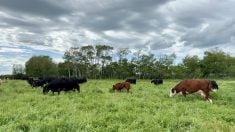As this article comes to print, it is early December and winter has gripped much of the country. Concurrent with this change in seasons, it is also a time of year when cattle feeders — cow-calf and feedlot alike — are settling into their winter-feeding programs. In the case of backgrounding and feedlot operations, hopefully cattle have adapted to the lot and are consuming rations formulated to meet projected gains. For cow-calf operators, it is a time when one looks to get cows through the main part of the winter in as economical a manner as possible. With cows in moderate to good condition (i.e. body condition score of 2.5 to 3.0), this typically involves feeding rations that maintain body condition as the animals move through mid-gestation, and ramping up their nutrition as they enter the last trimester of pregnancy. Winter conditions will also affect the health and performance of your animals. With this column, I want to focus on energy use in cattle and the effect of severe cold stress on the animal’s need for dietary energy.
Let’s start by looking at basic animal energetic concepts. Animals require energy for all biological functions including fundamental processes essential for life, milk production in the case of lactating females, fetal growth in pregnant females and growth in calves and yearlings. The energy requirement for maintenance is common to all animals. It is the energy required to keep the animal alive including maintaining body weight, carrying out essential metabolic processes, and that required to seek out a food source. While there are some breed, age, gender and physiological state (i.e. lactation) effects on the maintenance energy requirement, the largest determining factor is the animal’s body weight, with heavier animals requiring more maintenance energy (i.e. mega-calories per day) than lighter animals.
The energy required for milk production is based on the amount and composition of milk produced as well as the stage of lactation. Cows milking 20 pounds a day with 3.5 per cent milk fat will have a higher energy requirement than those producing 15 pounds of milk at the same milk fat concentration. Pregnancy requirements are based on days of gestation and estimated calf birth weight. As the pregnant cow moves through the last 90 days of gestation, her energy requirement increases due to the developing fetus.
Read Also

The Canadian Cattle Association’s international advocacy efforts
Global ag policies affect Canadian food policy, so the Canadian Cattle Association participates in international and domestic forums
[RELATED] Don’t focus solely on price when using raw screenings as winter feed
Finally, the energy requirement for body weight gain or the net energy for gain (NEg) requirement is determined by considering the animal’s weight, body composition, relative mature size and — most importantly — the desired body weight gain. All other things being equal, a 750-pound steer gaining 3.5 pounds a day will require a diet with a higher NEg than a 750-pound steer gaining 2.5 pounds a day.
Total net energy required (i.e. that adjusted for urinary, digestive, metabolic and fermentation losses) for a given animal will be a sum of these individual requirements. For example, a 1,300-pound cow in mid-gestation and maintained under “normal” environmental conditions only has to meet her maintenance energy requirement to maintain body condition. As she moves into the last trimester, not only does she need to meet her maintenance requirement, but she also must meet the gestation requirement if she is to maintain body condition. Similarly post-calving, the cow has combined requirements for maintenance and milk production. The second-calf heifer is unique in this regard in that she is still growing and thus has a certain NEg requirement over and above her needs for maintenance and pregnancy or lactation. For cattle in the feedlot, there is a need to meet both the net energy for maintenance and the target NEg requirement to achieve expected performance.
How then does environmental stress such as severe cold, high windchills or wet muddy conditions with no dry bedding pack influence the animal’s energy requirement? The answer is simple — animals stressed due to extreme cold have a higher net-energy-for-maintenance requirement. In other words, they require additional energy to keep warm. How much additional energy will depend on several factors including the animal’s body condition or fat stores, its hair coat and the degree to which it is environmentally stressed. With wintering cows, failure to meet this additional requirement will result in animals losing body condition with potential negative effects on fetal growth and on subsequent reproductive performance. In growing cattle, it will result in reduced or negative weight gain. It is for this reason that when severe winter weather hits, one has to increase the amount of feed offered or adjust the ration’s energy density.
The question one often gets is at what temperature do cattle become cold-stressed and require additional energy? While there is no firm answer to this question, -15 to -20 C or equivalent windchill temperatures are likely a good cut-off for cows in good body condition. Feeding an extra two pounds of grain for every 10 degrees the temperature drops below these values will help to keep the cow warm and from losing condition. Windbreaks and bedding are also a must, to keep cattle warm and productive during extreme environmental conditions.

















